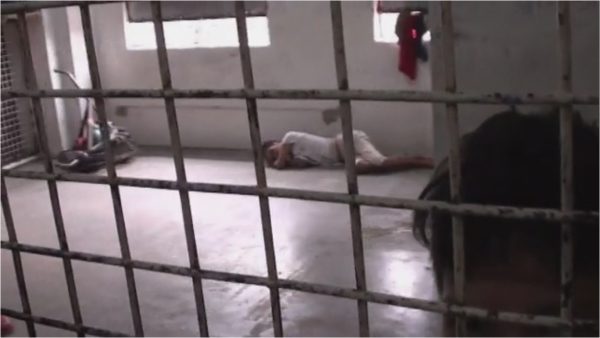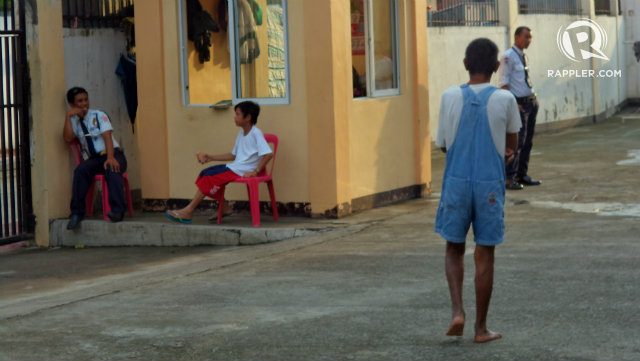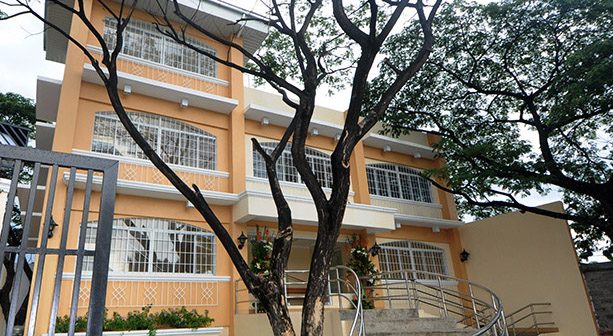SUMMARY
This is AI generated summarization, which may have errors. For context, always refer to the full article.

Part 2 of 3
READ: Part 1: Beyond juvenile delinquency: Why children break the law
MANILA, Philippines – Rehabilitation is a crucial factor in reintegrating into society children in conflict with the law (CICL). But sometimes the very centers mandated to help them fall short of doing so.
Such is the case in Caloocan City’s Yakap-Bata Holding Center, where 34 CICL are detained. It is too cramped for these children, said a mother whose son has been inside for nearly 4 months now. (READ: On 2nd chances: Children in conflict with the law)
Crowded juvenile centers with dismal conditions are not exclusive to Yakap-Bata, as it is a prevalent condition among youth homes and other shelters. (READ: Finding ‘Frederico’)
In 2013, Republic Act 10630 was passed to amend the Juvenile Justice Act of 2006. The new legislation allows children as young as 12 years old to be held criminally liable for serious crimes such as rape and murder, among others.
The law also mandates local government units to establish “houses of hope” or Bahay Pag-Asa (BPA) to offer rehabilitation, diversion, and intervention.
But as with most legislations, implementation of RA 10630 remains a challenge for LGUs, whose years of neglect have allowed for inhumane conditions of children inside youth centers.
Yakap-Bata
The Yakap-Bata Holding Center was established in 2010 even before LGUs were mandated to manage youth homes. But 4 years since RA 10630 was enacted into law, CICL in Caloocan are made to stay in a center reeking with foul odor, swallowed by cramped spaces and iron bars.
Rappler went to Yakap-Bata but was not allowed to enter its premises. They allowed us to interview a child offender and a social worker but only in the office of the city social worker department head.
A city hall worker, who refused to be named, said the condition inside the center is “not conducive” to children’s development and is “not child-friendly.”
The department has restricted access to the center, the employee said, especially after the media wrote about conditions.
The center is located on the 3rd floor of the building in the city hall compound. The second level is where local residents can obtain marriage licenses, among others.
Aurora*, 56, is a mother of a 16-year-old boy who has been detained in the center for 3 months due to alleged drug use. Aurora told Rappler her son has asked her to help get him out because of the difficult conditions inside.
“Sabi nya sa akin: ‘Ma, pakitang tao lang ang mga ‘yan. Kunwari ‘pag may bisita maayos kami at may pagkain. Pero pag wala, iba na sila,” Aurora told Rappler.
(He told me: ‘Ma, they are just putting up a show. When there are visitors, they make it seem like we’re fine and there’s food. When the visitors are gone, they become different.)
Her son complained of no food, lack of space to move around, and unsanitary surroundings. According to a piece in the Inquirer, children “eat with their hands and get drinking water from the broken faucet in the bathroom.”
Aurora said Yakap-Bata children wear torn clothes. The Juvenile Justice Welfare Council requires that children be given 4 sets of new clothing and essential toiletries upon arrival at house of hope.
Aurora added the overpowering smell of the toilet each time she visits her son is something you can’t ignore.
Her son supposedly told her: “Ma, tulungan mo ko makaalis dito. Impiyerno rito. Hindi ito DSWD (Department of Social Welfare and Development.) Kung DSWD ito, makakapaglaro kami. Doon na lang ako sa city jail, makakagalaw pa ako doon, mabuti pa doon.”
(Ma, help me leave this place. This is hell. This is not DSWD. If this were DSWD, I would be allowed to play. I prefer the city jail, where I can move around. It’s better there.)
Aurora said children there have no activities. Since it’s located on the 3rd floor of the city hall building, children are not allowed to play and even go outside.
Rappler asked the city hall employee if the following Yakap-Bata pictures posted a few years ago by Preda Foundation, a human rights organization, still mirror present conditions. The employee nodded.


Rappler also obtained current photos inside Yakap-Bata.


Robert Quizon, officer-in-charge of the city social welfare department, refuted Aurora’s claims.
Quizon said the city government has increased the food budget to P140 per child from P100.
“Hindi totoo yun. Nilakihan ng city, ginawa na ngang P140. Malabo yun,” Quizon told Rappler in a phone interview. (That is not true. The city increased the budget to P140. That’s not possible.)
Asked about the alleged jail-like situation inside Yakap-Bata, Quizon said: “Hindi totoo yun. Minsan lang more on sa nakikita or observation nila ang pinanghahawakan ng mga bisita, di sila magtanong sa amin. Katunayan niyan, may mga taga-UP (University of the Philippines) and DSWD na bumaba na dito sa amin, sila mismo dapat ang nagsabi sa amin kung may mali silang nakita.”
(That is not true. Sometimes visitors just focus more on what they see and their observations instead of asking us about them. In fact, there are those from UP and DSWD who have visited us. They should be the ones to tell us if they saw anything wrong.)
“Mukha lang kulungan in a sense. Pero meron po kaming pinapagawang bago yun na ang aming Bahay Pag-Asa,” Quizon said, adding they are still unsure when they can transfer to the newly-built youth home. (It looks like a prison in a sense but we are already building a new one, our Bahay Pag-Asa.)
Substandard, unmanned LGU-run centers?
RA 10630 mandates that each province and highly-urbanized city “shall be responsible for building, funding, and operating a ‘Bahay Pag-asa’ (BPA) within their jurisdiction following the standards that will be set by DSWD and adopted by the JJWC.” The minimum age for children who can be brought to youth-care facilities such as BPA is 12 years old.
Preda earlier told Rappler that while children have no longer been detained in prison since 2006, some BPAs are not far from jails.
“Most of these LGU-run centers are substandard, young children are abused by older, bigger children, sometimes even with the knowledge and worse, consent of the staff,” Francis Bermido Jr, executive director of Preda Foundation, earlier said.
Such is the situation even in centers sponsored by the DSWD. Social Welfare Secretary Judy Taguiwalo said there is no 1:1 bed capacity ratio in centers primarily due to overcrowding. She is now asking for additional budget for the construction of Bahay Pag-Asa for CICL.
“The National Training School for Boys (NTSB) is overcrowded and cannot comply with the set standards. The increasing number of clients being served makes it necessary and urgent for the DSWD to ask for an increased budget so we can hire additional staff and so we can expand the facilities the clients and the centers need,” Taguiwalo said.
According to the JJWC, there are at least two out of the 16 cities and one municipality required to run a BPA that have received first-level accreditation from the DSWD. This is only in Metro Manila. But other cities, municipalities, and far-flung areas have the same problem.
Another problem is the lack of well-trained staff to support children in conflict with the law. Ideally, there should be a ratio of one social worker to 25 CICL but what happens on the ground is far from reality.
Yakap-Bata has only one social worker, Rowelyn Acdog. As of November 2016, there are 34 CICL in the center. But that number could sometimes increase to 50. The Manila Youth Reception Center has only 6 workers, with each handling more than 30 children. Other BPAs have the same situation.
Rappler contacted MYRC but it did not respond to a request for an interview or visit.
Hope remains in Bahay Pag-Asa
In the nearby city of Valenzuela, the locally funded Bahay Pag-Asa is a stark contrast to Caloocan’s Yakap-Bata – well-ventilated rooms, enough space for kids to play, activities for children, and no pungent smell of human waste.
Andy*, 18 years old, accused of raping his 7-year-old cousin and adoptive sister when he was 16 years old, has been in the center for nearly two years now. He has focused his time on drawing, with the center employing an art teacher for the kids.
The teenage boys are also allowed to communicate with the girls residing in the adjacent Bahay Kalinga.
Social worker Mary June Paundog said their resident doctors have suggested that boys be allowed to communicate with the opposite sex. After all, they are in the stage of puberty and preventing them from doing so could rob them of that experience, she added.
“They do sign language across the window. That’s it. Sometimes they write to express their thoughts,” Paundog said.
Andy said his house parent once allowed him to talk to his then girlfriend for 5 minutes. This served as his reward for doing well in a task.


Paundog, however, said they also experience having more children than what the center could take.
At present, there are more than 60 CICL when the center could only ideally accommodate 35. But so far, she said the condition of the children has not suffered.
Paundog said another reason why the center goes beyond capacity is that children who have no families to return to prefer to stay in the center. There are instances, she said, when already released children come knocking on the center’s doors again because they have no food or place to sleep in their own homes.
“Technically, wala siyang batas pero for the best interest of the child. Kasi kung magbabatas-batas tayo di puwede. Pero mas hahayaan mo ba sila na nasa labas na walang pamilya? But as much as possible hinahanapan namin ng paraan, hinahanap namin ang tito at tita maski nasa malayong probinsya,” she said.
(Technically, it’s not in the law but it’s for the best interest of the child. Because if we just base it on the law, it’s not allowed. But would you let them stay outside without a family? But as much as possible we find ways to get them their guardians, we look for an aunt and uncle even if they are in the provinces.)
Not enough space, not enough budget, not enough social workers for an increasing number of CICL. That leaves the children, who go in for rehabilitation, not much of a choice nor a chance for change and a better future. – Rappler.com
Part 3: Children in conflict with the law: Cracks in Juvenile Justice Act
Add a comment
How does this make you feel?
There are no comments yet. Add your comment to start the conversation.